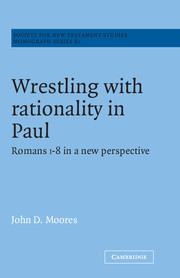Book contents
- Frontmatter
- Contents
- Acknowledgements
- List of abbreviations
- Introduction: The layout of this study and the approach behind it
- 1 Enthymematic semiosis in Paul
- 2 Varieties of enthymematic effect in Romans 1–4
- 3 Ways in which enthymemes arise in Romans 5–7
- 4 How enthymematic argument stands in Romans 8
- 5 Knowing what tune Paul is playing
- Conclusions reached their scope assessed
- Notes
- Bibliography
- Index of names
- Index of technical terms
1 - Enthymematic semiosis in Paul
Published online by Cambridge University Press: 08 October 2009
- Frontmatter
- Contents
- Acknowledgements
- List of abbreviations
- Introduction: The layout of this study and the approach behind it
- 1 Enthymematic semiosis in Paul
- 2 Varieties of enthymematic effect in Romans 1–4
- 3 Ways in which enthymemes arise in Romans 5–7
- 4 How enthymematic argument stands in Romans 8
- 5 Knowing what tune Paul is playing
- Conclusions reached their scope assessed
- Notes
- Bibliography
- Index of names
- Index of technical terms
Summary
A semiotic perspective for the study of Pauline argument. Umberto Eco's ‘typology of modes of sign-production’.
‘It is very difficult to imagine an imprint that mentions a referent without the mediation of a content.’ This is a comment which the semiologist Umberto Eco is prompted to make in relation to the significance which Robinson Crusoe reads into the human footprint which he comes upon on the island where he is shipwrecked. The message may be spelt out thus: ‘There is at least one other human being on this island in addition to me.’ The referent which the imprint, by virtue of its form, ‘mentions’ is ‘human being’, but the ‘mention’ does not come about for Crusoe on this occasion without the mediation of a content which the words ‘human being’ alone do not adequately represent. He does not think ‘human being’ except as ‘a particular human being who must be my fellow inhabitant on this island’.
This example illustrates one mode of the operation which Eco defines as ‘sign-production’. It is the mode which he refers to as ‘Recognition’. It is the first of four modes into which he distinguishes ‘sign-production’. The others are Ostension, Replica and Invention. It is a feature of Eco's general theory of semiotics that the object of semiological study should be understood not as the sign itself but as the production of signs.
- Type
- Chapter
- Information
- Wrestling with Rationality in PaulRomans 1-8 in a New Perspective, pp. 5 - 32Publisher: Cambridge University PressPrint publication year: 1995

